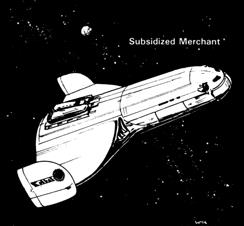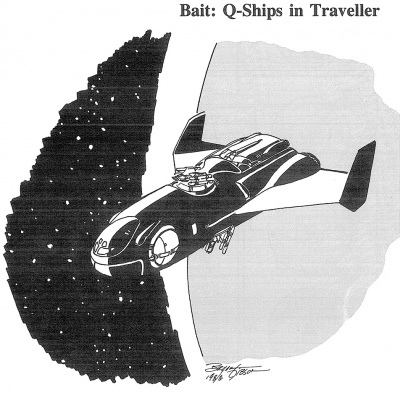Difference between revisions of "Akkigish class Subsidized Merchant"
| Line 49: | Line 49: | ||
|architect = | |architect = | ||
| | | | ||
| − | |QSP = | + | |QSP = AK-AS12 |
|crewExtension = | |crewExtension = | ||
| − | |USP = | + | |USP = AK-4211111 000000 10001-0 |
| | | | ||
|blueprint = Yes | |blueprint = Yes | ||
Latest revision as of 10:31, 27 May 2022
| Akkigish class Subsidized Merchant | |
|---|---|
 A Vilani classic ship. | |
| Type: AK Subsidized Merchant | |
| Category | ACS |
| Size | 400 Tons |
| Hull Configuration | Close Structure Hull |
| Streamlining | Streamlined Hull |
| Tech Level | TL–9 |
| Engineering | |
| Computer | Model/1 |
| Jump | J-1 |
| Maneuver | 1 G |
| Armaments | |
| Hardpoints | 2 |
| Accommodations | |
| Staterooms | 13 |
| Low Berths | 9 |
| Personnel | |
| Crew | 5 |
| Officers | 2 |
| Enlisted | 3 |
| High/Mid Passengers | 7 |
| Low Passengers | 9 |
| Payload | |
| Cargo | 200 Tons |
| Fuel tank | 50 Tons |
| Carried craft | 1 20t Launch |
| Construction | |
| Construction Time | 14 Months |
| Origin | Third Imperium |
| Price | |
| Cost | MCr101.03 |
| Statistics | |
| Quick Ship Profile | AK-AS12 |
| Universal Ship Profile | AK-4211111 000000 10001-0 |
| Images | |
| Blueprint | Yes |
| Illustration | Yes |
| Source | |
| Canon | Published, canon design |
| Designer | Marc Miller |
| Design System | Book 2, GURPS |
| Era | 1105 |
The Akkigish class Subsidized Merchant is a civilian Subsidized Merchant. The Akkigish is largely designed around use as a subsidized merchant.
Description[edit]
The Akkigish-class is the prototypical and oldest of the Type R class Subsidized Merchant merchant vessels. The design standards are a standby in shipyards across Charted Space, even outside of the Third Imperium. Subsidized Merchants are usually found operating a set route where part of the operating expenses are met by an outside party in return for some guarantee (usually a courier contract or a regular shipment/passenger contract of some kind). Usually a part of the hold or one or more passenger cabins will be reserved for the use of the subsidizer, and the ship required to service a set and scheduled route.
Constructed using the type 400 hull, the subsidized merchant has jump drive-C, maneuver drive-C, and power plant-C, giving performance of jump-1 and 1-G acceleration. Fuel tankage is 50 tons, sufficient for one jump, plus some maneuver. Fuel scoops are integral with the hull, and a fuel purification plant allows use of unrefined fuel. The rather ordinary bridge is complemented with a Model/1 computer and two tons of fire control for the ship's two turrets. The ship has thirteen staterooms (five for the crew; eight for high or middle passengers); there are nine low berths. The crew consists of a captain/pilot, navigator, medic, steward, and engineer. There exists the potential for two gunners as crew members if weaponry is installed. The ship carries a 20-ton launch for passenger shuttling and minor errands; it is piloted by the navigator or an engineer. Cargo capacity is 200.0 tons. [1]
No turrets or weaponry are installed, but there are two hardpoints and two tons are set aside for fire control. The ship has one 20-ton launch. Cargo capacity is 200 tons. The ship is streamlined. [2]
The Fat Trader requires a crew of five: pilot, navigator, engineer, medic, and steward. The pilot also operates the launch; gunners may be added to the crew list as required. The ship costs MCr101.03 and typically takes fourteen months to build. [3]
Its electronics were hardened for hard deep space use and its engines were designed for minimal maintenance. The power plant was very capable for its size and built to be endlessly expanded and modernized as newer technologies premiered. The hull is solid, and the air control surfaces are effective in atmospheres and in gas giants for wilderness refueling. Even the freshers and galley were well designed for its time.
Dimensions: 46.5 meters long by 10 meters high by 15 meters wide. Wingspan: 32 meters. [4]
The Launch mounted dorsally with integral lifeboat capability, the launch is also used for errands and transfers. Launch mounts for the boat are located on dorsal surface of merchant dismounts for errands and transfers. Maneuver Drives are mounted underneath the fuselage of the Ship’s Boat. [5] A 10-ton Lifeboat may be substituted for the launch if desired. Members of the crew will be cross-trained as small-craft crew for operating the Launch or Lifeboat.
Image Repository[edit]
- A Type R in deep spaceflight, far from a mainworld, probably coming into a wilderness refueling.

- A conversion to a Gyro Cadis class Subsidized Merchant, into a Q-Ship.

General Description & Deck Plans[edit]
The subsidized merchant is built on a two level plan. The lower deck contains a full access tunnel-type cargo area adapted to containerized cargo. Each cargo module (of 3.85 tons) can be positioned on the deck and removed through bow, rear, or side doors. The cargo-loading templates show the actual configurations which will pass through the various doors.
The lower level also contains the drives and fuel scoops for the ship's tanks. Fuel is contained in the wings and wing-tips. Small crawlways extend into the wings for access to the landing legs and for exiting beneath the wings.
The upper level contains passenger and crew staterooms, the lounges, the bridge, and the galley. The rear portion of the upper level contains the ship's power plant and the low berths. The transverse bulkhead midway through the upper level is a pressure barrier designed to reduce losses in the event of a hull puncture.
Passenger loading is generally performed using the 20-ton ship's launch. The launch calls at the main starport or even at a local hotel's landing pads and picks up passengers booked for the flight. The ship itself is already in orbit, and the launch mates directly with the berth on the ship's dorsal surface. Passengers then board using the launch access hatch. The launch has provision for eight passengers in addition to the pilot. It can carry 9 tons of cargo.
History & Background[edit]
The Akkigish-class is truly ancient vessel, literally first manufactured thousands of years ago near the end of the Ziru Sirka period. They were superbly built to last and last they have. Some hulls have been literally built and rebuilt dozens upon dozens of times, constantly upgraded with local parts and in local shipyards on their trade routes.
The Akkigishes were solidly built and are still preferred despite newer models such as the March-class or Gyro Cadiz-class being available. When a spacer mentions the Type R class Subsidized Merchant, many picture a trusty Akkigish.
Class Naming Practice/s & Peculiarities[edit]
There also exists a Akkigish class Far Trader variant, which uses the same hull and basic layout.
Selected Variant Types & Classes[edit]
42 Representative Subsidized Trader (AK) Classes[edit]
A
- Akkigish class Subsidized Merchant
- Amkarim class Trade Liner
- Andrew class Commercial Shuttle
- Anhk class Merchant
B
C
D
F
G
J
- Jasper class Provincial Merchant
- Jelmirt Marquis class High Liner
- Jose Cadiz Royal Galleon class Cargo Carrier
K
L
M
- Maru class Merchant
- Mauripo class Subsidized Merchant
- Mavuzo class Super Freighter
- Mora class Freighter
P
Q
R
S
- Seeker class Armored Merchant
- Sirocco class Merchant Freighter
- Star*mart class Provincial Merchant
- Swordfish class Merchant
T
- Trader class Provincial Transport
- Type CT class Cargo Carrier
- Type R2 class Subsidized Merchant
- Type RL class Subsidized Merchant
- Type RL2 class Subsidized Merchant
- Tyrfing class Freighter
V
References[edit]
| This article has metadata. |

|
This ship was originally designed using one of the Classic Traveller ship design rules:
|

|
This ship was originally designed using GURPS Traveller ship design rules.
|
- Marc Miller. Starships (Game Designers Workshop, 1977), 19.
- Marc Miller. Traders and Gunboats (Game Designers Workshop, 1980), 19-22.
- Rob Caswell, William W. Connors, Joe Fugate, Gary L. Thomas. Starship Operator's Manual (Digest Group Publications, 1988), 58.
- Loren Wiseman. GURPS Traveller Core Rules (Steve Jackson Games, 1998), 146.
- Kenneth Witt. Elvwood Site.
- ↑ Marc Miller. Traders and Gunboats (Game Designers Workshop, 1980), 19.
- ↑ Marc Miller. Starships (Game Designers Workshop, 1977), 19.
- ↑ Marc Miller. Starships (Game Designers Workshop, 1977), 19.
- ↑ Marc Miller. Traders and Gunboats (Game Designers Workshop, 1980), 21.
- ↑ Marc Miller. Traders and Gunboats (Game Designers Workshop, 1980), 21.